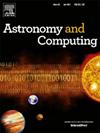非洲II。使用Numba和Dask校准无线电干涉仪数据
IF 1.8
4区 物理与天体物理
Q2 ASTRONOMY & ASTROPHYSICS
引用次数: 0
摘要
校准是,并将继续是无线电干涉测量数据减少的一个组成部分。然而,随着更大、更灵敏的无线电干涉仪的构思和建造,校准问题在规模和难度上都在增长。增大的尺寸可以归因于这样一个事实,即数据量与阵列中天线的数量成二次增长。此外,新仪器可能比它们的前辈多出两个数量级的通道。同时,灵敏度的提高使校准更具挑战性:低水平的RFI和校准伪影(在生成的图像中)以前会被噪声所包含,现在可能会限制动态范围,并最终限制衍生的科学。正是在这种背景下,我们引入了QuartiCal:一个新的Python包实现无线电干涉校准例程。在灵活性和性能方面,QuartiCal改进了其前身CubiCal。虽然使用了相同的数学框架-使用Wirtinger导数的复杂优化,但该方法已经过改进以支持参数化增益项的任意长度链。QuartiCal利用Dask (Python中用于并行计算的库)将校准表示为令人尴尬的并行任务图。这些任务图可以(在一些约束条件下)映射到许多不同的硬件配置上,从而允许QuartiCal从在消费者硬件上本地运行扩展到基于云的分布式集群。使用MeerKAT对PSR J2009-2026的观测证明了QuartiCal的定性行为。这些定性结果之后,分析了QuartiCal在许多校准场景和硬件配置下的运行时间和内存占用方面的性能。本文章由计算机程序翻译,如有差异,请以英文原文为准。
Africanus II. QuartiCal: Calibrating radio interferometer data at scale using Numba and Dask
Calibration is, and will remain, an integral component of radio interferometric data reduction. However, as larger, more sensitive radio interferometers are conceived and built, the calibration problem grows in both size and difficulty.
The increasing size can be attributed to the fact that the data volume scales quadratically with the number of antennas in an array. Additionally, new instruments may have up to two orders of magnitude more channels than their predecessors. Simultaneously, increasing sensitivity is making calibration more challenging: low-level RFI and calibration artefacts (in the resulting images) which would previously have been subsumed by the noise may now limit dynamic range and, ultimately, the derived science.
It is against this backdrop that we introduce QuartiCal: a new Python package implementing radio interferometric calibration routines. QuartiCal improves upon its predecessor, CubiCal, in terms of both flexibility and performance. Whilst the same mathematical framework – complex optimization using Wirtinger derivatives – is in use, the approach has been refined to support arbitrary length chains of parameterized gain terms.
QuartiCal utilizes Dask, a library for parallel computing in Python, to express calibration as an embarrassingly parallel task graph. These task graphs can (with some constraints) be mapped onto a number of different hardware configurations, allowing QuartiCal to scale from running locally on consumer hardware to a distributed, cloud-based cluster.
QuartiCal’s qualitative behaviour is demonstrated using MeerKAT observations of PSR J2009-2026. These qualitative results are followed by an analysis of QuartiCal’s performance in terms of wall time and memory footprint for a number of calibration scenarios and hardware configurations.
求助全文
通过发布文献求助,成功后即可免费获取论文全文。
去求助
来源期刊

Astronomy and Computing
ASTRONOMY & ASTROPHYSICSCOMPUTER SCIENCE,-COMPUTER SCIENCE, INTERDISCIPLINARY APPLICATIONS
CiteScore
4.10
自引率
8.00%
发文量
67
期刊介绍:
Astronomy and Computing is a peer-reviewed journal that focuses on the broad area between astronomy, computer science and information technology. The journal aims to publish the work of scientists and (software) engineers in all aspects of astronomical computing, including the collection, analysis, reduction, visualisation, preservation and dissemination of data, and the development of astronomical software and simulations. The journal covers applications for academic computer science techniques to astronomy, as well as novel applications of information technologies within astronomy.
 求助内容:
求助内容: 应助结果提醒方式:
应助结果提醒方式:


